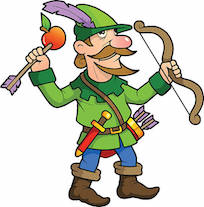Some of our relatives (Mike and Sue) recently got into archery. When I was a kid, we didn’t call it archery, we called it playing with bows and arrows. But I figured that if we get together in the future, I should be able to hold my own with them if the subject of archery comes up. So — I did a bit of extensive research and found some terms that I figured I might need to impress them….
Archer’s Paradox refers to the physics of archery, specifically when the arrow is released. It is the effect of how the arrow bends slightly around the bow when it leaves it.
Lincoln Logs is a way of referring to the arrows of larger than needed diameter shot by archers hoping that they might sneak into a higher scoring area of a target, just by hitting its line.
If you look closely at some targets, there is a small x dead center of the target. When your arrow hits that little x dead center, it’s called a spider. (?????)
A tomato is an arrow that hits in the red area of an archery target.
When you draw back your bow and your arrow releases sooner than you intended, it’s referred to as shooting with too much pinky.
When an archer is shooting a bow with a draw weight that’s way too heave for them, it causes them to shake and struggle — that earns the term “struggle stick.”
A term we hear around here often, starting around Thanksgiving is Hog — a term in hunting that refers to a large or trophy size deer.
And my favorite archery term is a Robin Hood — that’s when your arrow hits another arrow so perfectly that it splits the arrow that was already shot into the target.
While on the subject of archery, besides Robin Hood, my favorite archery hero is William tell — Switzerland’s national hero, revered for his gallant acts leading to Swill liberation. Over the years, his legend has grown and William Tell has become a universal symbol for Swiss’ freedom struggle.

Over 150 years after the foundation of the Swiss Confederacy the first references to William Tell can be found in Swiss writings. In Chronicon Helveticum, in 1550, historian Aegidius Tschudi provided the first detailed account of Tell’s heroism and his role in Swiss independence, including the story of him shooting an apple off his son’s head. Tschudi’s account became the definitive source of the legend for many artistic retellings over the following centuries.
Around the world William Tell came to represent rebellion against tyranny and even inspired some would-be assassins. John Wilkes Booth claimed Tell was his inspiration for the Assassination of Abraham Lincoln.
William Tell’s legacy is seeped in so much legend it it difficult to separate fact from fiction. He is so integral to Swiss nationalism that most Swiss people believe he did exist. Monuments to William Tell stand proudly throughout Switzerland.
But — there is no concrete historical evidence that William Tell actually lived.
The story of a marksman shooting an apple off a loved one’s head is nothing new — it appears in many other nation’s folklore including Denmark, Norway, Iceland, Persia and England. In fact, a very similar story came out of Denmark in the 12th century — a skilled hunter called Toko is forced to shoot an apple off his son’s head then escapes imprisonment to kill the tyrant, just like William tell.
Maybe the question of whether a man named William Tell actually lived 700 years ago is like the question of whether a masked Lone Ranger actually roamed the Old West righting wrongs. It’s impossible to prove that William Tell existed, but it’s equally impossible to prove that he didn’t. But it doesn’t really matter — even today, anyone that takes a stand against thugs and wrong doing can be sure that the spirit of William Tell stands with them.
— 30 —
